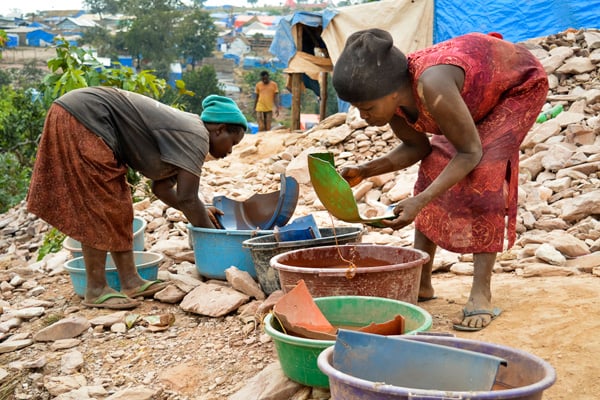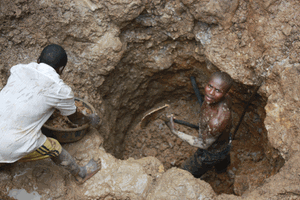
Small scale miners mining gold in Mubende District. Photo/Courtesy of Trek Africa Expeditions
Mining plays a prominent role in the economy worldwide since human efforts have been more concentrated in extraction than recycling of natural resources.
Ores composed of minerals vary according to the geological evolution. These are raw materials for the conventional industries producing mining products. They can also be used in new technologies. The mining industry triggers intense environmental and health impacts in the mining communities.
Uganda is one such a country rich in minerals where a fraction of communities derive their livelihood from mining minerals. These include gemstones, white marbles, sand, limestone, gold, zeolite, uranium, vermiculite, pozzolana deposits, diatomite, copper and iron ore among others. These mineral are providing communities engaged in Artisanal Small Scale mining daily incomes for them to earn a living.
However, human exposure to multiple small particles from mining effluent, such as stone dust, uranium, iron, lead, zinc, silicon, titanium, sulphur, nitrogen, platinum, chromium, vanadium, manganese and mercury is a health risk.
Background
Hazardous chemicals such as mercury, crystalline silica, carbon monoxide or hydrocarbon fumes, cyanide and mica associated with mining are harmful to people's health. In the long run the people engaged in the mining of these minerals are exposed to diseases associated with the mining processes leading to deaths.
This was revealed by experts in East and Southern Africa discussing Artisanal Small Scale Mining strategy during a consultative meeting by African Mineral Development Centre (AMDC) in Dar es Salam, Tanzania.
In a recent publication by science experts in the US based Biomedical Centre department of Public health, it is stated that the demand for large scale extraction of mineral and metal resources in Africa continues to rise, driven in part by the global shift towards a low-carbon future.
Citing the report of the United Nations Environment Programme (UNEP), the experts state that Africa holds a significant share of the world’s mineral reserves, approximately 30% located on the continent.
Additionally, Africa holds around 8% of the world’s natural gas reserves and 12% of oil reserves, making it a crucial player in meeting the rising global demand for minerals, metals, oil and natural gas.
Currently, Africa hosts over 2000 industrial mining projects and many more planned.
The continent’s rich resources present both opportunities and challenges for the local communities including Artisanal Small Scale Miners in the entire Africa and Uganda.
Monitor interacted with some of the health experts to discuss health challenges faced by mining communities.
Health concerns in the mining sector
Dr Omer El Nagieb from Centre for Occupational and Environmental Health Africa explaining the health dangers miners are faced with notes that investing in Occupational Health and Safety for mining communities is the responsibility of governments and citizens of the country.
He contends that there are diseases known as mining diseases which are clustered under occupational diseases.
Diseases
He cited the key diseases as Silica dust disease caused by dust obtained from crushed stones, sand and construction materials. If inhaled over a period of time, it will destroy the lungs leading to death.
Another disease is tuberculosis which is a result of inhalation of mineral dust which in turn damages the internal organs thereby causing chronic TB
HIV/Aids is also common health challenge in mining sites because people make quick money and tend to practice immorality leading to contraction of the virus and spreading it in communities.
Cardiovascular disease
Dr Omer went on to classify the diseases, one of them being cardiovascular diseases where he pointed out that approximately 18 million cardiovascular deaths occurred in 2017 worldwide and air pollution is directly linked to this high number
He explained that exposure to a high concentration of particle pollution is associated with an increased risk of myocardial infarction, stroke arrhythmias and heart failure and respiratory effects such as asthma attacks and bronchitis.
Particle pollution which is the main cause is primarily generated by mechanical processes performed by humans such as soil drilling, crushing of stones or processing any other type of mineral.
Ischemic heart disease is the leading cause of mortality due to Particle Pollution in air pollution.
Additionally, exposure to heavy metals is common in mining regions. Heavy metals can contaminate air, water, soil and food which becomes dangerous to the miners.
Cadmium, mercury and lead are notable known for their widespread contamination, long-lasting effects on the body and renal and cardiovascular toxicity
The toxicity of human exposure to high doses of inorganic mercury on the urinary and cardiovascular systems is well evidenced in mining places.
Furthermore there is an association between long-term exposure to inorganic mercury as experienced by miners and millers with an increased risk of cardiovascular mortality.
Neurological disorders
Reports have shown that pollution contributes to stroke, multiple sclerosis and Alzheimer's disease where connection of the brain cells is degenerated.
The leading cause that triggers these diseases is too much hazardous chemicals from a mix of hazard elements, such as heavy metals and particle pollution.
Respiratory system diseases
The lungs are acutely affected by exposure to particles released from the mining process. Depending on the process, particles with different diameters can be generated. The size of particles is relevant as it influences their behaviour in the body when inhaled and the effects on the individual's health
Pneumoconiosis is a disease resulting from inhalation and consequent deposition and accumulation of inorganic particles in the lungs. It is noted that the physiological effects vary according to the particle inhaled.
Kidney damage diseases
The decrease in mining and the interruption of several mining companies made available large areas of contaminated land which more recently are used for agricultural activities and domestic occupation.
Contaminants in these areas are composed of several agents that pose a risk to human health such as cadmium, arsenic, lead and mercury causing renal diseases in humans.
This weakness the Kidney which will not be in position to filter waste occurrence as a result of mining activity.
Solution
Dr Omer explained that usually the Artisanal small scale mining communities comprise of children and women as the majority especially in areas where stone quarry mining is taking place
This therefore calls for governments to ensure health care services are provided.
It is important for governments to establish basic health care centres in the mining locations for health services to be accessed.
It is also important to train the mind-set of the miners to go and conduct tests against certain common diseases for better management.
Most of the miners are not aware about the health dangers they are faced with therefore it is important to provide capacity building on primary health care and ensure health workers are present on these sites to provide health surveillance.
But most important governments must provide Occupational Health Services to the miners wherever they may be.
Uganda’s Key mining health challenge
Vincent Kedi, the Commissioner in charge of licensing and the Ministry of Energy and Mineral developed explained that although most Artisanal Small Scale miners suffer all other diseases, the key one for Uganda’s miners has been diseases leading to kidney and brain damage arising from Mercury use.
Most people mining Gold have tendency of using Mercury to process the gold during the mining exercise especially in Busia, Bwehuju, Mubende gold mining sites.
Miners usually the mercury which is poured in water the separate sand from the Gold. These water may end up in water bodies used by humans and mercury remains can end up in food consumed by humans.
However the ministry has burnt the use of mercury and it is being implemented on ground since the miners have been given alternative use of a chemical called Borax.
Borax is a powdery white substance, also known as sodium borate which miners can use to wash the soil when processing Gold and it has no health hazard.
According Kedi, this chemical is cheap and affordable to the miners and they have shifted and abandoned mercury use.
Good mining practices
Kedi further explained that in 2022 Uganda passed the new mining and minerals law which integrated regulations governing Artisanal Small Scale mining practices including health safety, gender equality as well as environmental protection
The law includes provisions to ensure responsible mining practices which provides for mining personnel to be equipped with appropriate personal equipment namely helmets, safety goggles, ear protection, gloves and steel-toed boots.
These essentials safeguard against potential hazards such as falling debris, loud noises and chemical and dust exposure.




